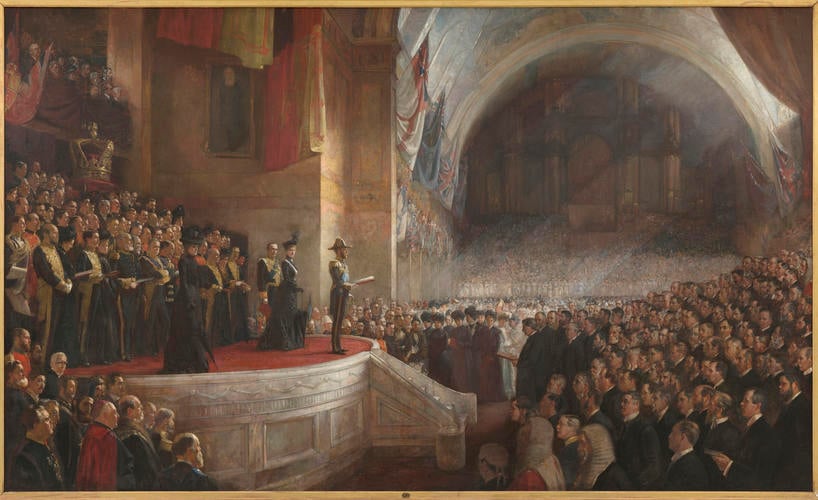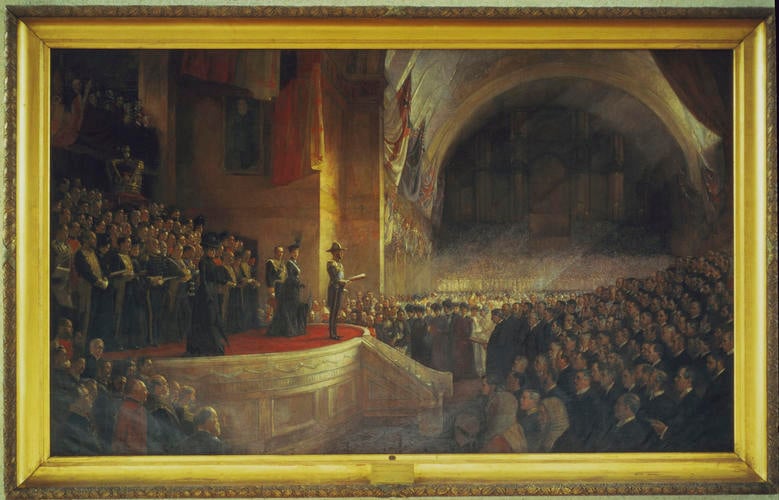-
1 of 253523 objects
The Opening of the First Parliament of the Commonwealth of Australia, 9th May 1901 c.1901-3
Oil on canvas | 358.4 x 504.3 cm (support, canvas/panel/stretcher external) | RCIN 407587

Tom Roberts (1856-1931)
The Opening of the First Parliament of the Commonwealth of Australia, 9th May 1901 c.1901-3

Tom Roberts (1856-1931)
The Opening of the First Parliament of the Commonwealth of Australia, 9th May 1901 c.1901-3


-
This monumental painting of the Opening of the First Parliament of the Commonwealth of Australia, convened in Melbourne on 9 May 1901, was commissioned by the Australian Art Association Proprietary Ltd and later presented to King Edward VII. Widely known now as the 'Big Picture', it took the British-born, Australian artist Tom Roberts over two years to complete, and, because of the scale and nature of the commission, presented enormous challenges.
It depicts the Duke of York (later King George V), standing upon a dais, within the crowded interior of the Exhibition Building, reading the proclamation from the King. Just behind him stands the Duchess of York (later Queen Mary) with, to her left and right, the Marquis of Linlithgo (Governor-General) and the Marchioness of Linlithgo. Grouped on the dais are the Governors of several States and members of the Royal suite, and facing the dais are the Senators and Members of the House of Representatives with the Prime Minister, Edmund Barton, and members of the Cabinet distinguishable in the first rows. In the background, to the right, appears the enormous organ, and to the left a portrait of Sir Henry Parkes. The death of Queen Victoria, only four months earlier, meant that all present are dressed in mourning which must have restricted Robert's palette, however the scene is enlivened by the white dais, the decorative flags which flank the walls of the interior and a shaft of sunlight.
Roberts received an invitation to attend the Opening (which was attended by over 12,000 people), but later recalled, that, unable to find a seat, he climbed 'up some rails… to see that immense gathering of people…The heads on the floor looked like a landscape stretching away.' The comparison is interesting as Roberts, who was best known as a landscape painter, would have almost certainly looked for the romantic possibilities of the scene, rather than realistic. And in fact, changes have been made to the scene to emphasise these picturesque aspects – rather than presenting a realistic depiction of the event.
The commission was first offered to James Clarke Waite, who later withdrew, and on 29 May, 1901 Roberts accepted a contract that stipulated that he was to produce, within a year, a canvas of not less than eight foot by four foot (approx. 244 x 122 cms), containing 140 recognisable faces. By August Roberts had decided to double the size; a second contract was drawn up, and he was to include 250 portraits. The fees were raised from 650 guineas to more than 1500 and his studio was to be the Exhibition building. Photographs of the period show Roberts within the cavernous interior at work on this 'machine' – the term for used for large canvases that required scaffolding to work on. By March 1903 the painting still was not finished and a third contract was signed; Roberts was to travel to London and the painting was to be completed by 1 November 1903.
The Duke and Duchess of Cornwall and York left England on 15 March, 1901 on HMS Ophir, as part of an extensive Tour of the Empire, scheduled to include the opening of the first Parliament, arriving in Melbourne on May 6. On May 16 they left for Brisbane by train and travelled on to Sydney on 27 May. On 31 May the Duke gave a sitting to Roberts and at a ball at Government House Roberts wondered how he could give the impression of the Duchess of York's 'vivacity and winsomeness'. He approached the task of producing the other portrait sketches in a methodical manner; he logged the weight, height and hat size of each of his sitters and made notes on other characteristics. For example, for Archbishop Carr (the Roman Catholic Archbishop of Melbourne) he notes…'I want to get this portrait well done; it is a typical head of a prelate…' For King O Malley (later a Minister of the Crown) he commented…'wears a big hat; always talking; …very clean and frank.'
Comparison with contemporary photographs of the event and Charles Nuttall's rather stilted, realistic depiction of the scene (Museum Victoria, Melbourne) shows how artistic license has come into play and to what extent Roberts' vision is a romantic one, tinged with impressionism. The sloped dais, planted with flowers and ferns, has been replaced by a structured, white, architectural stage, echoing the arch of the ceiling; the flags and decorative crown to the left appear to be on a grander scale; Roberts has introduced a portrait of the late Sir Henry Parkes (1815-96) the founding father of the Federation, to the left. Finally, the broad shaft of sunlight entering the interior lifts the scene; contemporary reports suggest that the rainy weather outside had cleared, and when the Duke read the message from his father, King Edward VII 'the atmosphere was radiant, and illuminated the vast sea of faces with the a bright Australian glow': this was a momentous episode in the history of Australia.
Tom Roberts is one of the founders of Australian impressionism. He was born in Dorchester, England in 1856, but following his father's death in 1868 he settled in Melbourne, together with his mother and siblings. He studied first at the National Gallery School and then attended the Royal Academy Schools, London from 1881-2; subsequently travelling in Spain and Paris before returning to Australia in 1885. It was in Paris that he was influenced by contemporary developments in art; notably plein air painting, and was inspired by artists such as Whistler, and Bastien-Lepage. He travelled to England in March 1903, to complete his 'Big Picture', returning to Australia in 1919. Following his return to England in 1903 he exhibited at the Royal Academy from 1910 to 1919 and held a solo exhibition at Walker's Gallery, London in 1914. Roberts was prompted to take on this prestigious commission because he felt it would be lucrative, bringing him fame and a constant supply of portrait commissions, however these hoped for commissions failed to materialise. When he completed the painting on 6 November 1903 he wrote that he was finally 'off the chain'; he was exhausted and almost a broken man.
The painting was engraved by Goupil & Cie, in Paris, November 1903 and exhibited at the Royal Academy, the following year (No 768).
There are numerous sketches and drawings for the painting (see Helen Topliss, Tom Roberts, A Catalogue Raisonné, 1985, No 371).
Provenance
Presented to King Edward VII on 3 July 1904 as a gift from the Commonwealth of Australia; hanging at St James's Palace until 1957, when placed on loan to Parliament House, Canberra.
-
Creator(s)
Acquirer(s)
Subject(s)
-
Medium and techniques
Oil on canvas
Measurements
358.4 x 504.3 cm (support, canvas/panel/stretcher external)
Category
Object type(s)